
Throwback Thursday is a weekly article in which we look back at our favorite TV episodes from the past.
Forever was a gem of a show that, unfortunately, only lasted one season. It tells the story of Henry Morgan, who cannot stay dead. Every time he dies, he ends up alive in the nearest body of water. In this iteration of his life, he is the medical examiner of New York City, where he helps detectives Jo Martinez and Mike Hanson solve crimes. He is also joined by his adopted son, Abraham, who now looks more like his grandfather than his son. This episode aired on Feb. 3, 2015 and is directed by David Warren and written by Matthew Miller and Sarah Nicole Jones. You can catch the whole series of Forever at cwtv.com. I chose this episode, not because it is my favorite, but because it sets up a key storyline about Abraham’s search for information on his birth family. I intend to cover the next episode when it is my turn to do Throwback Thursday again.
As we open, a health aide is taking Abe’s vitals much to Henrys’ chagrin. It turns out that Abe is just getting an insurance physical and is in very good health. The woman asks for Abe’s parents’ health records before seeing Abe’s Auschwitz tattoo. It’s as awkward as it sounds but Abe reassures her as she leaves. Ever-supportive, Henry tells Abe that they can check the records at the Holocaust Museum again to find out information abut Abe’s birth parents, but Abe says it’s useless without a family name. He knows nothing about his parents because he was too young when they died and he can’t even remember what they looked like. Henry is concerned about his son, but Abe says, “Anway, you can dwell on the past or, um…” Henry: “Or what?” Abe: “Appreciate the present. Focus on cheerier things. (The phone rings and he answers it) It’s Jo for you. There’s been a murder. So much for cheerier things.” Ha! Off Henry goes.
In keeping with the Nazi theme, the dead guy, Karl Haas, is an art dealer who has a swastika imprinted in his head. The statute that killed him is called the Andolini Venus and it has the Nazi symbol tagged on the bottom, showing that is was stolen in the 1940’s. Back at the morgue, Lucas, the coroner assistant, is intrigued. Lucas: “It’s just…a swastika embedded into a dead guy’s head? Stolen Nazi art? What is this guy, Indiana Jones?” Henry: “Who is Indiana Jones?” Lucas: “Is that a joke? Seriously?” I agree. Henry, you’re 200 years old. You can’t take in a movie? Detectives Martinez and Hanson join the subsequent exposition to add that Haas’ father was notorious Nazi art plunderer, Otto Heydrich. They assume that Haas is equally guilty and that his death might be the byproduct of an illicit art deal gone bad. They bring in Haas’ son, Erik, but he claims not to know anything about his family’s Nazi history. In fact, he vehemently denies it. This leads to the first flashback of the episode, where Henry is confronted with the fact that his family’s shipping business includes slavery in the West Indies. Henry, too, vehemently denies the allegations only to find that it is true. He is devastated. In a later flashback, he confronts his father, who used slavery to pay down the family’s outstanding debts. Henry is so outraged that he decides to leave the UK for America, wanting nothing to do with the family business.
In the present, Henry uses Haas’ rare watch and trace elements on his shoes to track down Eli Swier, a watchmaker in Brighton Beach. Initially, Swier denies any knowledge of Haas to Jo and Henry, but after learning of Haas’ death, he admits that he gave the watch to him. Why? Because Haas returned a priceless Monet painting to Swier, a painting stolen by the Nazis when Swier was just a kid. Surprise! Haas was actually trying to right the wrongs of his family, only asking that the families keep his name a secret. Swier quotes Goethe: “A good man apologizes for the mistakes of the past, but a great man corrects them.” Swier: “Karl Haas was a great man.” Back home, Henry and Abe debate why Haas wanted to keep everything a secret. Henry: “I suppose one obvious answer is that he didn’t want to be further associated with who his father really was - a war criminal.” Abe: “Well I guess it didn’t work out then.” Henry: “Because he was killed?” Abe: “No, you said he changed his name, hid out in his apartment, and had a cr** relationship with his kid, so he couldn’t escape it. Luckily, we’re only responsible for our own sins in this world. Can you imagine if I tried to carry around your 200 years of craziness?” Ha! Abe makes several good points here. Haas was haunted by his father’s actions to the point that it damaged his future and his relationship with his son. This is a nice tie to the opening scene where Abe tries to live in the present instead of being chained to the past.
The conversation ends when Henry gets a call informing him that the blood at the scene matches Max Brenner, an artist that has been dead for 20 years. Henry: “It seems our victim was murdered by a dead man.” Or not. Hanson: "If this Max Brenner guy has been dead since the 90's, how'd he break into an apartment and kill Karl Haas?" Henry: "Well it's quite simple actually…" Lucas: "Max Brenner is a zombie Nazi hunter. Huh? What? We were all thinking it." Bwah!!! Since most adults understand the basics of DNA, Henry’s exposition here is pointless. Suffice it to say, the next police stop is to Sam Brenner, Max’s son. When Martinez and Henry get there, he is hacking up a dead animal with a chain saw and splattering its blood everywhere. Blech! How anyone would buy that as art is beyond me! Sam admits that he broke into Haas’ house to recover one of his dad’s paintings that was also looted by the Nazis. Martinez comments that the painting is not very cheery but Henry explains that it depicts the Todesengel, angel of death, and was supposed to be a warning against the rise of Nazism. Speaking of death omens, Adam is back. Ugh! A few episodes before, Adam revealed that he, too, is immortal and he preceded to frame Henry for murder. It didn’t go well. Abe, oblivious to who Adam really is, receives a silver platter from him to appraise. When Abe shows it to Henry, Henry sees his family crest on it and immediately knows that Adam is playing games again.
Henry takes Adam’s business card and arranges to meet with him. (He does not share who Adam is with Abe, which is always a bad idea.) Adam approaches Henry like they are old friends, but Henry shuts that down right away. Henry: “I don’t know what game you’re playing, but if you so much as touch Abraham, you’ll live to regret it.” Adam: “As opposed to what?” Good point, but still, no one better mess with Abe. Adam assures Henry that he would never hurt Abe, because they have a lot in common. Adam was in Auschwitz, too, in 1945, but not as a Nazi. He was a prisoner, who was tortured by Josef Mengele, once they figured out that he was no ordinary man. Adam: “Take it from me, Henry. There are evils in this world that even you haven’t encountered.” The flashback is brutal and it had me feeling sorry for Adam. I never did like the Adam storyline, but fleshing out his backstory here did make me look at him in a different way. Adam asks for Henry’s help in finding a 44 BC Roman dagger that the Nazis took from him. He knew of Haas’ father and thinks that the dagger might be in his’ collection. He implies that if Henry helps him, he has something that might help Abe.
Meanwhile, the case leads them to a bank vault full of looted artwork valued at billions of dollars. The account manager, Julian Glausser, tells Martinez that Haas kept the paintings there until he could track down their next of kin. It is a long, arduous process that involves looking into the detailed notebooks of the Nazis. Henry realizes that one of the paintings stolen from Haas’ house was a Rembrandt. Apparently, Rembrandt was known for using the equivalent of poison oak in the pigment dyes he used. Huh? This makes no sense to me but it does lead Martinez and Hanson to the culprit, since Julian kept scratching at his hand in the first interview. Sadly, when they go to bring Julian in, they discover that he has looted the vault and is now on the lam. Martinez wants Hanson to call his brother Anthony, who works the Port Authority, but Hanson is justifiably reluctant since his brother and he bicker on and on about old wounds until Martinez puts a stop to it. Anthony agrees to close the port on 2 occasions: 1. They excuse his parking tickets. 2. Hanson apologizes for screwing his prom date. Yikes! The conversation ends when a container above them starts dripping blood. Inside is the art and Julian’s dead body with cuts all over it. He was tortured.
The differences in the deaths bothers Henry, who surmises that there are 2 different killers. While Julian was tortured and showed evidence of a long, painful death by a sadist, Haas was killed quickly and his body was posed reverently in love. Martinez points out that bashing someone’s skull in is not loving, but Henry claims that you can love and hate someone at the same time. He flashes back to his father’s deathbed. Henry comes to see him one last time before he leaves for the US. He is still angry and refuses anything that belongs to the Morgan family, until his dad hands him the family watch. Dad: “There are 2 things we are charged with in this life, Henry. Living with our mistakes and endeavoring to learn for them, to be better men because of them. No matter what you think of me, I know I have raised a good man.” Then his father dies. Back in the present, Henry realizes that someone closed Haas’ eyes and the fingerprints show it was his son. No surprise there. Apparently, Julian told Erik about his family’s Nazi past. Struggling to pay the rent, Erik wants to sell some of the artwork but his dad refuses. They fight and Haas ends up dead but Erik swears that he did not harm Julian. One crime solved; the other crime is weirder. Lucas exposits that the blood samples taken in the cargo container where Julian died had anomalies. They contained evidence of over 2,000 years of diseases. Henry realizes that Adam killed Julian but he quickly shoots down any questions Lucas or the detectives have. They, in turn, are shocked when Henry says he has no theories.
Adam heads back to Abe’s antique shop and talks cryptically about everything. In a nut shell, he did not find the dagger he was looking for but he did snatch a book from Auschwitz out of the art collection. He leaves it for Abe and, using their tattoo numbers, Abe learns the names of his father and mother, Herman and Reba Weinraub. He shares his joy with Henry and calls Adam an angel, but Henry quickly confirms Adam’s identity. Abe rightly calls Henry out for not sharing that info sooner, but Henry exposits Adam’s situation and supposes that the ledger is Adam’s way of apologizing for earlier. He doesn’t forgive Adam but Abe reminds him that Adam was a victim, too. Later, Henry and Abe go to the Holocaust Museum and now that Abe has his parents’ names, they give him a box of his parents’ things. In it is a picture of their wedding. For the first time that he can remember, Abe knows what his parents look like and it is pure joy. Abe: “Well, I guess I know now where I get my good looks from.” Aww.
To be honest, I prefer the next episode to this one but I wanted to lay the groundwork for Abe and Henry’s relationship here. It is by far the best thing about this series. Due to Henry being immortal, his son is now visibly older than he is and it creates a unique dynamic between them. Their shared secret has created a strong bond and it shows in how protective they are with each other. Henry shares the pain of Abe not knowing anything about his parents, but Abe also wants to shield Henry from that pain. Their mutual joy at seeing the picture of Abe’s birth family is palpable and ends the episode on such an emotional high point. This episode not only fills in some of the gaps in Abe’s history, but it also explains why Henry left the UK to come to America and lays the groundwork for how he sees the world. Although the weekly crime here is pretty basic, the episode has good character interactions, ample backstory for all including Adam, and scenes with a heavy emotional punch. It was a joy to relive it so many years later.
Grade: B+
Best Reason to Watch - Abe back story
Best Scene - Abe knows his family's real name for the first time and sees his parent's wedding picture
Biggest Hmmm? - it would be far more likely that a white man from the West Indies was pro-slavery than calling someone else out on it in those days
The "Not Him Again" Award - Adam, Henry's stalker is back
Biggest "Well Duh?" Moment - Henry exposits that the dead guy's son shares his DNA
Best Con - Julian, who steals billions in looted Nazi art
Least Surprising - the man's son killed him
Most Disgusting - animal blood as art
Best Surprise - instead of Adam being a Nazi, he was tortured by them / Adam is the means by which Abe gets to know his family
Best Quotes -
1. Henry, about the statue: "Look at how the artist captured the lines of the body almost perfectly." Jo, about the corpse: "Fascinating. I'm a little more concerned with the body on the floor."
2. Abe: "Luckily we're only responsible for our own sins in this world. Can you imagine if I tried to carry around your 200-years of craziness?"
3. Jo, after Henry spoils her info: "You know you kind of take the fun out of these reveals."
4. Hanson: "If this Max Brenner guy has been dead since the 90's, how'd he break into an apartment and kill Karl Haas?" Henry: "Well it's quite simple actually…" Lucas: "Max Brenner is a zombie Nazi hunter. Huh? What? We were all thinking it."
5. Lucas: “It’s just…a swastika embedded into a dead guy’s head? Stolen Nazi art? What is this guy, Indiana Jones?” Henry: “Who is Indiana Jones?” Lucas: “Is that a joke? Seriously?”
Screencaps by Kiss Them Goodbye

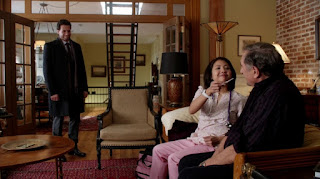
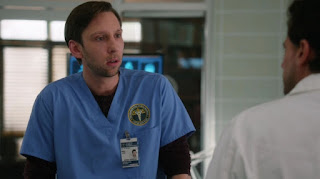



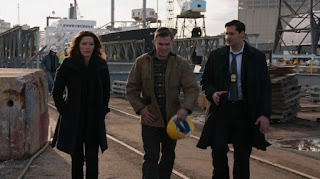

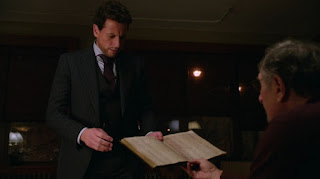



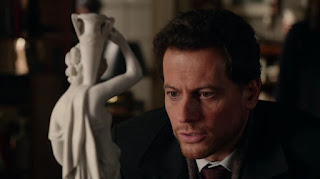

No comments:
Post a Comment